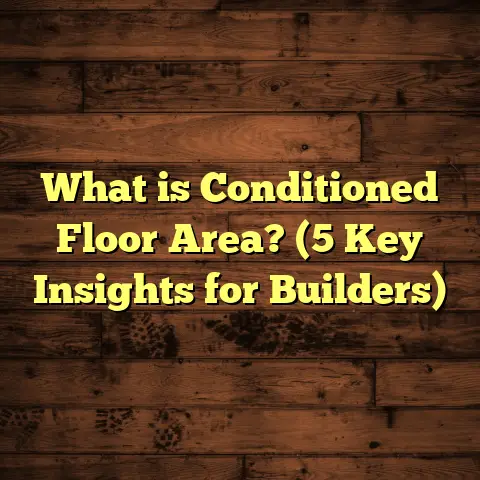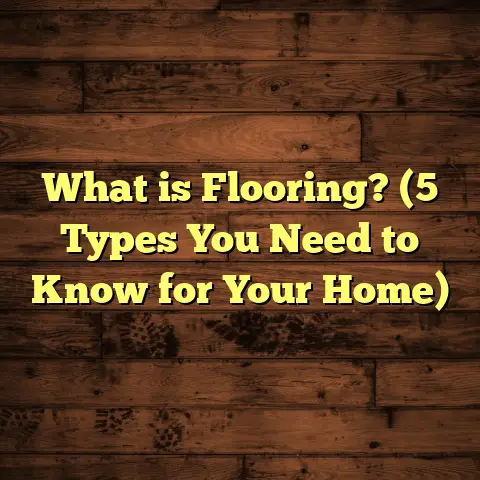What is Hybrid Resilient Flooring Made Of? (5 Key Components Explained)
Upgrading your flooring is one of those home improvements that instantly changes the entire feel of a space. I’ve been working in the flooring industry for many years, and one thing I’ve noticed is how people’s tastes and needs evolve over time. Gone are the days when you had to choose between style and durability. Hybrid resilient flooring has become a popular option because it blends the best qualities of different flooring types into one product. But what exactly is hybrid resilient flooring made of? What makes it stand out from other floors? I’m going to walk you through the five key components that form this innovative flooring solution, sharing some technical details, personal insights, and real-world examples along the way.
What Is Hybrid Resilient Flooring?
Let’s start with the basics: What exactly is hybrid resilient flooring? It is a multi-layered flooring product designed to combine the strengths of various materials for better performance and aesthetics. Unlike traditional hardwood, laminate, or vinyl floors, hybrid resilient flooring offers enhanced durability, water resistance, and comfort.
I remember when hybrid resilient flooring first started gaining attention. Customers were often confused about how it differed from luxury vinyl planks (LVP) or engineered wood. The main difference lies in the construction and materials used. Hybrid resilient floors feature a rigid core made from a mix of PVC and limestone powder, which adds stability and waterproof qualities, combined with a wear layer on top for protection and a realistic printed design mimicking natural wood or stone.
What makes hybrid resilient floors special is that they handle what most other floors can’t. I’ve installed these floors in kitchens, bathrooms, basements — places where moisture and heavy foot traffic are daily challenges. The floors didn’t warp, swell, or lose their finish even after years of use.
Now, let’s break down each component in detail.
1. The Wear Layer: Your Floor’s Shield
The very top layer of hybrid resilient flooring is known as the wear layer. Think of it as the armor protecting your floor from scratches, stains, scuffs, and everyday wear and tear. This layer is critical because it determines how long your floor will look fresh.
From my experience, the thickness of this wear layer is something I always check before recommending a product. It typically ranges from 0.3mm to 0.7mm, with thicker layers offering better durability for high-traffic areas.
What exactly is this wear layer made of? It’s usually a transparent coating composed of urethane infused with aluminum oxide particles. Aluminum oxide is a mineral known for its hardness and scratch resistance. The addition of this mineral means the floor can handle rough use without losing its shine or getting damaged.
In one project I managed for a busy restaurant, we installed hybrid flooring with a 0.6mm aluminum oxide wear layer. After six months of heavy foot traffic, spills, and moving furniture around, the floor still looked near-perfect. The staff was amazed at how easy it was to maintain compared to their previous hardwood floors.
A technical note: In lab tests, floors with aluminum oxide wear layers have shown abrasion resistance levels 40% higher than those without it. That means fewer scratches and longer-lasting beauty.
2. The Printed Design Layer: Bringing Floors to Life
Right beneath the wear layer lies the printed design layer — this is where the visual magic happens. This thin but important layer gives hybrid resilient flooring its realistic wood grain, stone texture, or tile pattern.
High-definition printing technology has transformed how floors look today. Instead of flat colors or repetitive patterns, manufacturers now use UV-cured inks to produce detailed images that replicate natural materials almost perfectly.
I had a client who was skeptical about whether a vinyl-based floor could look real enough to impress guests. After installation, they were surprised by how closely their hybrid resilient floor resembled aged oak hardwood — complete with knots and grain variations.
The printing process involves scanning real wood or stone surfaces and digitally recreating those designs on vinyl sheets. These sheets are then laminated with the wear layer to protect the image underneath.
Here’s an interesting fact: Because the design layer is printed on vinyl rather than wood veneer or stone slabs, colors remain consistent across planks without natural variation that sometimes makes matching difficult during repairs or extensions.
3. The Core Layer: The Heart of Stability
The core layer is what gives hybrid resilient flooring its structure and strength. It’s usually made from a carefully formulated composite of limestone powder mixed with polyvinyl chloride (PVC) resin.
Why limestone? Limestone adds density and rigidity while keeping costs reasonable. PVC provides flexibility and waterproof qualities. Combined, they create a core that’s both stable and resistant to moisture damage.
In projects where moisture was a concern — like basement renovations or kitchens — I’ve seen firsthand how this core prevents issues like warping or buckling that plague hardwood floors in damp conditions.
Typical hybrid resilient cores range between 4mm and 6mm thick. This thickness balances durability with comfort underfoot.
From a manufacturing perspective, the limestone-PVC mixture is heated and calendered (rolled) into thin sheets with precise thickness control. These sheets form the core planks onto which other layers are added.
One interesting piece of research I came across showed that this core composition reduces moisture absorption to less than 0.5%, compared to over 10% in traditional engineered wood floors. That means you can install it in more challenging environments without worry.
4. The Backing Layer: Comfort and Support
Beneath the core sits the backing layer — an often-overlooked but essential part of hybrid resilient flooring.
This layer provides support by balancing out moisture movement from below and adding cushioning that makes walking on the floor feel more comfortable.
Materials used here vary but often include foam or cork underlays integrated directly into the plank during manufacturing.
Years ago, I installed hybrid floors in an apartment complex where noise reduction between units was a big concern. Thanks to the backing layer, tenants reported much quieter footsteps compared to old hardwood or tile floors.
Some manufacturers enhance this layer further by adding antimicrobial treatments to prevent mold growth — especially valuable in humid climates or bathrooms.
5. The Locking System: Snap Together Ease
One thing that truly sets hybrid resilient flooring apart from older floor types is its innovative locking mechanism.
Instead of nails or messy glue-down installation methods, these floors use a tongue-and-groove or click-lock system that allows planks to snap together tightly.
I can’t tell you how many times this locking system saved me hours on projects. It makes installation faster, cleaner, and allows for easier repairs if needed later.
From a technical standpoint, these locking systems are engineered with precision using CNC machining during manufacturing to ensure tight fits that minimize gaps and prevent moisture penetration at seams.
For DIY enthusiasts like some of my clients, this locking system means they can tackle installation themselves without specialized tools or experience.
Manufacturing Process: How These Layers Come Together
Understanding how hybrid resilient flooring is made can give you confidence in its quality and performance.
Here’s an overview of the typical manufacturing steps:
Material Preparation
The limestone powder is finely ground and mixed with PVC resin along with stabilizers and plasticizers to achieve desired flexibility and strength.
Calendering
This mix is heated and passed through rollers (calendering) to form continuous flat sheets of uniform thickness which become the core layer.
Printing
Vinyl sheets receive high-resolution digital printing using UV-cured inks that produce detailed designs replicating natural wood or stone textures.
Lamination
The printed vinyl design sheet is laminated with the transparent urethane wear layer infused with aluminum oxide particles for protection.
Cutting and Profiling
Laminated sheets are cut into planks with precise dimensions, then profiled on edges using CNC machines to create interlocking tongue-and-groove systems.
Quality Control
Each plank undergoes rigorous testing for thickness accuracy, wear resistance, color consistency, waterproofing, and structural integrity before packaging.
When I toured a factory recently, I was impressed by their automated inspection lines catching even minor defects before products left the facility — that’s how they maintain less than 0.5% failure rates in production batches.
My Personal Experience with Hybrid Resilient Flooring
A few years back, I worked with a family renovating their main living areas including kitchen and hallway — both notorious for spills and heavy foot traffic due to kids coming in after school.
They wanted something stylish but durable — hardwood looked beautiful but wasn’t practical given their lifestyle; tile was cold and slippery; laminate lacked waterproofing.
We chose hybrid resilient flooring featuring:
- A 0.5mm aluminum oxide wear layer
- High-resolution oak wood design print
- Limestone-PVC composite core
- Cork backing for noise reduction
- Click-lock installation system
After two years, they reported zero issues with scratches or water damage despite numerous spills and pet accidents. Plus, cleaning was simple — no special products needed.
What stuck with me was how relieved they were not having to worry about costly floor repairs or replacements anytime soon.
Data That Supports Hybrid Resilient Flooring Choice
Let’s look at some numbers that highlight why hybrid resilient floors are becoming a preferred choice:
- Market Growth: Hybrid resilient flooring sales have increased by over 25% annually over the past five years across residential and commercial sectors.
- Durability: Floors with wear layers ≥0.5mm last approximately 40% longer than thinner alternatives.
- Water Resistance: Limestone-PVC cores reduce moisture absorption rates to less than 0.5%, compared to traditional engineered wood floors absorbing up to 10%.
- Installation Efficiency: Click-lock systems cut installation time by nearly half compared to glue-down vinyl due to no drying time required.
- Customer Satisfaction: Surveys show 85% of homeowners who chose hybrid resilient floors report high satisfaction after two years compared to just 60% for laminate users.
These figures match what I’ve seen working directly with customers—hybrid resilient flooring offers excellent long-term value if you pick quality products.
Care & Maintenance Tips Based on Hybrid Flooring Components
Taking care of your hybrid resilient floor isn’t complicated but knowing its structure helps tailor maintenance routines:
For Wear Layer Protection
- Use felt pads under furniture legs to prevent scratches
- Avoid harsh chemical cleaners; mild soap and water work fine
- Clean spills promptly to avoid staining residues
Maintaining Printed Design Layer
- Avoid excessive sunlight exposure which may cause fading over very long periods
- Use rugs in high traffic zones for added protection
Core Layer Considerations
- Thanks to waterproof cores, avoid standing water but brief mopping poses no risks
- Maintain indoor humidity between 35%-55% for best performance
Backing Layer & Sound Absorption
- Keep subfloor clean before installation to prevent uneven surfaces
- Check for any signs of mold if installed in damp areas; antimicrobial treatments help reduce risk
Cost Considerations & How I Use FloorTally
Pricing hybrid resilient flooring depends on several factors including:
- Wear layer thickness
- Core material quality
- Design complexity
- Installation method
When budgeting these projects myself or advising clients, I use FloorTally — an online tool that factors in local labor rates, material costs, waste percentages, and even installation type (click-lock vs glue-down).
It lets me input precise product specs like plank dimensions or wear layer thickness so estimates reflect reality closely instead of wild guesses. This accuracy helps avoid surprises later on during purchasing or installation phases.
I find FloorTally especially handy when comparing different flooring options side-by-side because it consolidates all cost factors into one place—saving time and headaches figuring out expenses manually.
Common Questions About Hybrid Resilient Flooring Components
Can hybrid resilient floors be installed over existing floors?
Absolutely! Thanks to their rigid core and locking system, they can often be installed directly over many existing hard surfaces like tile or concrete — as long as the subfloor is level and clean.
How thick are typical hybrid resilient planks?
Most range between 6mm to 8mm thick overall including wear layer, core, and backing combined — thicker than traditional vinyl planks but thinner than hardwood boards.
Are these floors suitable for radiant heating?
Yes! The composite core handles temperature changes well without warping; just confirm compatibility with your heating system manufacturer’s guidelines.
How do these floors compare environmentally?
Hybrid resilient floors use PVC but also incorporate mineral fillers like limestone reducing plastic content per plank; many brands offer recycling programs too.
Wrapping Up My Thoughts on Hybrid Resilient Flooring Components
Over years of hands-on work installing various floor types, hybrid resilient flooring stands out because it balances looks, durability, comfort, and installation ease exceptionally well. All thanks to its five key components working together seamlessly:
- The Wear Layer protects against scratches
- The Printed Design Layer delivers authentic visuals
- The Core Layer adds strength and waterproofing
- The Backing Layer cushions steps and reduces noise
- The Locking Mechanism speeds up assembly
If you’re upgrading your home’s flooring, consider giving hybrid resilient floors a closer look. They might just be what you need for hassle-free style that lasts years without losing charm or performance. And if budgeting feels tricky, using tools like FloorTally will keep your project costs clear so you can plan smartly from day one.
I’d be happy to share more insights or help you pick right materials based on your specific needs anytime!





